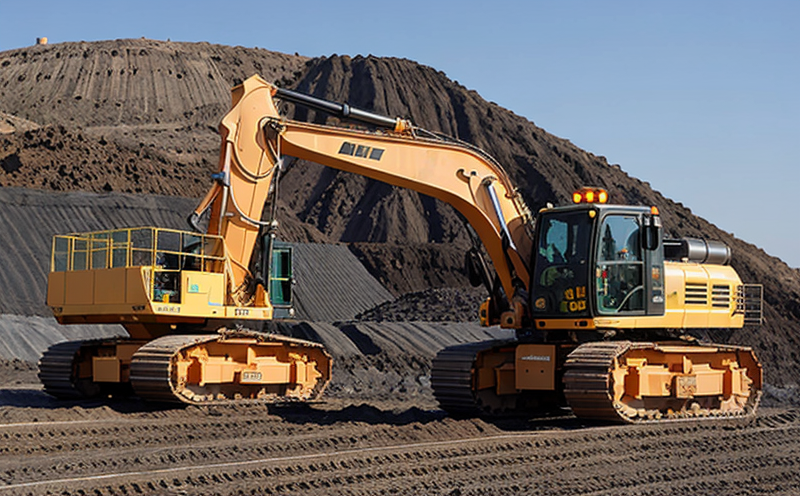SAE J386 Seat Belt System Testing for Mining Equipment
The SAE J386 specification is a critical standard that defines the performance requirements and testing procedures for seat belt systems used in mining equipment. Mining environments present unique challenges, including harsh conditions such as extreme temperatures, dust, and mechanical stress. The robustness of seat belts is essential to ensure the safety of operators in these demanding settings.
The primary purpose of SAE J386 testing is to evaluate the durability, strength, and reliability of seat belt systems under simulated operational conditions. This ensures that mining equipment meets stringent safety standards, thereby protecting workers from potential injuries or fatalities. The test protocol covers a range of parameters including tensile strength, abrasion resistance, and fatigue life.
Testing typically involves subjecting the seat belts to a series of stress cycles that mimic real-world usage scenarios. These tests are conducted using specialized equipment designed to simulate the dynamic forces experienced during mining operations. Compliance with SAE J386 is mandatory for manufacturers seeking certification in certain regions, and it also serves as a benchmark for quality assurance.
The testing process begins with thorough preparation of the seat belt samples. This includes cleaning the belts to remove any contaminants that could affect test results. Once prepared, the samples are subjected to various loading conditions that simulate both static and dynamic forces encountered during use. The test parameters are closely monitored using high-precision instrumentation to ensure accurate measurement.
After undergoing the prescribed tests, the seat belts undergo a rigorous evaluation process where their performance is compared against established criteria outlined in SAE J386. Compliance with these standards ensures that the equipment meets the necessary safety requirements and can be trusted for use in mining applications.
The results of the testing are meticulously documented and reported. These reports serve as critical evidence for compliance with regulatory requirements and provide valuable insights into the performance characteristics of the seat belts tested. This information is invaluable for quality managers, R&D engineers, and procurement teams who rely on it to make informed decisions about product selection and improvement.
The importance of SAE J386 testing cannot be overstated, especially given the critical role that safety equipment plays in mining operations. By adhering to this standard, manufacturers can ensure that their products meet the highest safety standards, thereby safeguarding workers and enhancing overall operational efficiency.
Benefits
Implementing SAE J386 seat belt system testing offers numerous benefits beyond mere compliance with regulatory requirements. Firstly, it enhances worker safety by ensuring that all seat belts used in mining equipment meet the highest durability and reliability standards. This reduces the risk of accidents and injuries, contributing to a safer work environment.
Secondly, successful completion of SAE J386 testing can significantly boost a manufacturer's reputation and market credibility. Compliance with international standards like SAE J386 is often seen as a mark of quality and reliability, attracting more customers and partnerships.
Thirdly, the detailed documentation generated during the testing process provides valuable data for continuous improvement efforts within R&D departments. This information can be used to refine manufacturing processes and design iterations, leading to more robust and efficient products.
Lastly, adherence to SAE J386 helps organizations stay ahead of regulatory changes and industry trends. By proactively addressing these standards, companies demonstrate their commitment to safety and quality, positioning themselves as leaders in the mining equipment sector.
Industry Applications
The application of SAE J386 seat belt system testing is not limited to traditional mining equipment but extends to various sectors where robust safety standards are crucial. Construction machinery, agricultural equipment, and even some types of heavy-duty vehicles often incorporate similar safety features as those required by SAE J386.
In the context of mining operations, these seat belts play a vital role in protecting operators from potential hazards such as falls or being caught between moving parts. The durability and reliability ensured by SAE J386 testing are essential for maintaining high levels of operational safety across all environments where heavy equipment is deployed.
For manufacturers operating within the mining sector, complying with SAE J386 not only meets regulatory requirements but also enhances their competitive edge in terms of product quality and worker safety. By adhering to this standard, companies can ensure that their products meet the stringent demands set forth by industry best practices.
Eurolab Advantages
At Eurolab, we pride ourselves on delivering comprehensive SAE J386 seat belt system testing services tailored to meet the unique needs of mining equipment manufacturers. Our state-of-the-art facilities and experienced technical staff ensure that every test adheres strictly to international standards.
Our team utilizes cutting-edge instrumentation capable of accurately measuring even the subtlest variations in performance metrics. This precision allows us to provide reliable data that can be trusted for both regulatory compliance and internal quality assurance purposes.
We understand the critical role that safety equipment plays in mining operations, which is why we offer flexible scheduling options to accommodate clients' busy production schedules without compromising on accuracy or thoroughness.
Additionally, our comprehensive reporting service ensures that all findings are clearly communicated through detailed reports that include recommendations for improvement where necessary. This transparency fosters trust between us and our customers while supporting their ongoing efforts towards maintaining the highest levels of operational safety.





